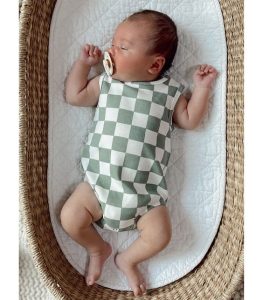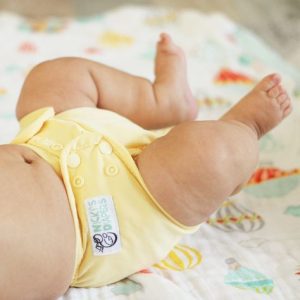Newborn babies go through a lot of diapers – an average of 8 to 10 per day! This can be surprising for new parents. How often do you change newborn diapers? Here’s a guide to help you determine how often to change your newborn’s diaper.
Frequency of Diaper Changes for Newborns
Newborn babies pee and poop frequently, so frequent diaper changes are essential to prevent diaper rash and discomfort. Here are some general guidelines:
Every 2-3 hours:
This is a good rule of thumb for diaper changes throughout the day and night.
After each feeding:
Newborns often pee or poop after eating. Change newborn diapers after feeding helps prevent diaper leaks and irritation.
When the diaper feels full:
Check your baby’s diaper frequently throughout the day. If it feels heavy or wet, it’s time for a change.
Signs Your Baby Needs a Diaper Change
Newborn babies can’t tell you when they need a diaper change, so it’s important to be observant. Here are some signs to watch for:
- A full or bulging diaper: This is the most obvious sign your baby needs a change.
- Fussiness or crying: A full diaper can be uncomfortable for your baby and make them fussy.
- Redness around the diaper area: This could be a sign of diaper rash, which can be caused by a wet or dirty diaper.
- A strong smell: If you notice a strong odor, it’s time for a change.
Important Considerations for Diaper Changes
Here are some additional things to keep in mind when changing newborn diapers.
- Always wash your hands: Before and after each diaper change, wash your hands thoroughly with soap and warm water. This helps prevent the spread of germs.
- Gently clean your baby: Use warm water and a gentle baby wipe to clean your baby’s diaper area. Avoid using harsh soaps or rubbing the skin.
- Pat dry completely: Always pat your baby’s skin dry with a soft towel before putting on a new diaper.
Nighttime Diaper Changes
Newborn babies typically sleep for longer stretches at night, but they may still need a diaper change. Here are some tips for nighttime diaper changes:
- Use a dim light: A bright light can disrupt your baby’s sleep. Use a dim nightlight for diaper changes.
- Keep diaper changing supplies close by: Have everything you need for a diaper change readily available at night to minimize disruption.
- Change if the diaper is heavy or leaky: You may not need to change a diaper at every nighttime feeding if it’s not full or leaking. However, if the diaper feels heavy or leaks, change it to prevent discomfort.
Following Your Baby’s Cues
While these are general guidelines, the most important thing is to follow your baby’s cues. Some babies may need diaper changes more frequently than others. Pay attention to your baby’s behavior and adjust your diaper changing routine accordingly.
Newborn babies go through a lot of diapers, and frequent changes are essential for their comfort and hygiene. By following these guidelines and paying attention to your baby’s cues, you can ensure your little one stays clean and comfortable.
Diaper Rash Prevention and Treatment
Frequent diaper changes are crucial to prevent diaper rash, but sometimes it can still happen. Here’s what you need to know:
- Causes of diaper rash: Diaper rash can be caused by irritation from wet or dirty diapers, friction from rubbing, or sensitivity to certain products.
- Signs of diaper rash: Look for redness, bumps, or tenderness in your baby’s diaper area.
Tips to Prevent Diaper Rash
Here are some tips to help prevent diaper rash:
- Change diapers frequently: As mentioned earlier, frequent diaper changes are key.
- Clean with warm water and gentle wipes: Avoid harsh soaps and alcohol-based wipes.
- Pat dry completely: Moisture can irritate your baby’s skin.
- Allow diaper-free time: When possible, let your baby have some diaper-free time each day to air out their skin.
- Choose fragrance-free products: Opt for fragrance-free diapers, wipes, and lotions.
Treating Diaper Rash
If your baby does develop diaper rash, here are some tips for treatment:
- Increase diaper changes: Change your baby’s diaper even more frequently than usual.
- Let diaper area air out: Allow for more diaper-free time throughout the day.
- Use a petroleum jelly-based ointment: Apply a thin layer of petroleum jelly-based ointment to protect the skin.
When to Call the Doctor
If your baby’s diaper rash is severe, doesn’t improve within a few days, or is accompanied by fever, consult your pediatrician. They can recommend additional treatment options.
Frequent diaper changes and proper hygiene are the best ways to keep your newborn clean and comfortable. By following these tips, you can help prevent diaper rash and ensure your baby thrives.

Diaper Changing Supplies and Organization
Being prepared with the right supplies can make diaper changes go smoothly. Here’s a list of essentials to have on hand:
- Diapers: Choose diapers that fit your baby well and prevent leaks. Consider trying different brands to find the best fit and absorbency for your baby.
- Wipes: Opt for fragrance-free, gentle wipes to avoid irritating your baby’s skin. Consider using warm water and washcloths for added gentleness.
- Diaper rash cream: A petroleum jelly-based ointment can help soothe and protect minor diaper rash.
- Changing pad: A waterproof changing pad on a flat surface provides a comfortable space for diaper changes.
- Bins for disposal: Have a designated bin for dirty diapers. Invest in a diaper pail with odor control if desired.
Organization is key! Keep all your diaper changing supplies within easy reach of your changing station. This can help minimize stress and make change newborn diapers more efficient, especially during nighttime changes.
Travel Tips for Diaper Changes
Even with newborns, adventures await! Here are some tips for change newborn diapers on the go:
- Packing essentials: Pack enough diapers, wipes, rash cream, and plastic bags for dirty diapers to last your outing.
- Portable changing pad: A portable changing pad provides a clean surface for diaper changes anywhere.
- Public restrooms: Many public restrooms have changing tables available. Be sure to bring your own supplies and always sanitize the surface before using it.
With a little planning and the right supplies, you can confidently navigate diaper changes on the go.









